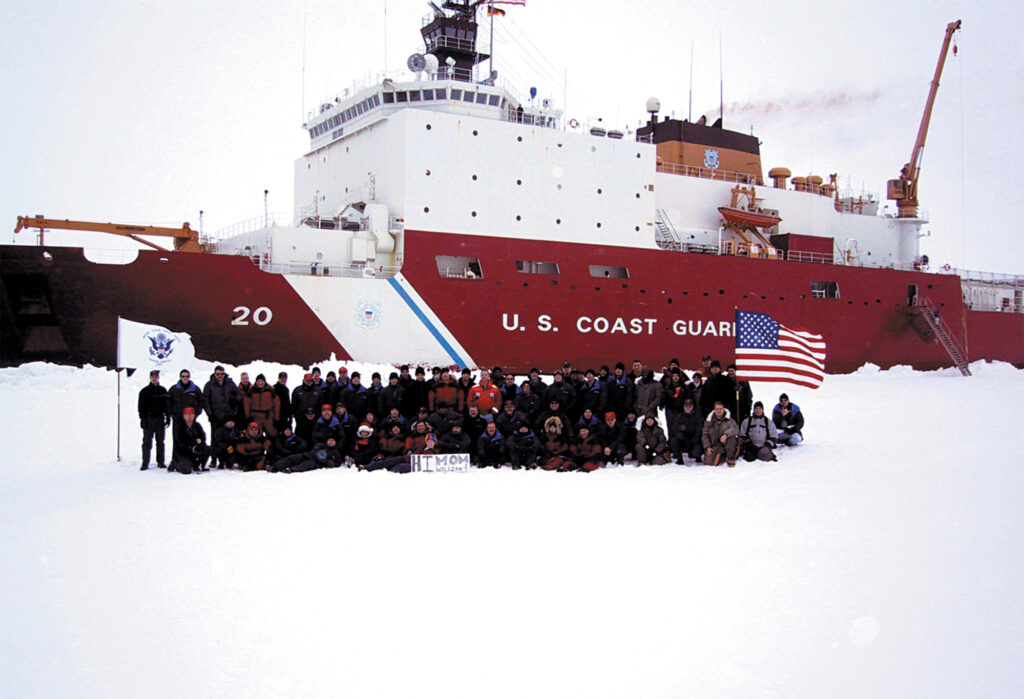As Chinese Ships Cruise Arctic For First Time, Will U.S. Build New Icebreakers?
Posted on
 UPDATED: WITH WHITE HOUSE STATEMENT ON BUYING MORE ICE BREAKERS
UPDATED: WITH WHITE HOUSE STATEMENT ON BUYING MORE ICE BREAKERS
WASHINGTON: After seven years of thinking about the possibilities, the Obama administration now says it wants to build at least one serious icebreaker in the face of increasing competition for the oil, gas, fish and shipping routes the Arctic can offer.
Right now, we’ve got two truly operational ice breakers: the Coast Guard Cutter Polar Star, a 399-foot heavy icebreaker commissioned in 1976, and the Healy, a 420-foot medium icebreaker commissioned in 2000.
But it will take the Coast Guard about a decade to build an ice breaker using the standard acquisition approach, says one of America’s most experienced Arctic sailors, retired Rear Adm. Jeffrey Garrett. If we’re serious about getting something into the water, Garrett says we could do it in about four years, but that would mean greatly foreshortening a lot of the traditional acquisition approach used to build Coast Guard ships.
President Obama. using his visit to the Arctic as backdrop, issued a statement Thursday saying his “administration will propose to accelerate acquisition of a replacement heavy icebreaker to 2020 from 2022, begin planning for construction of additional icebreakers, and call on Congress to work with the Administration to provide sufficient resources to fund these critical investments.”
But proposing to accelerate something that isn’t being built yet is hard, especially when you’ve really only got one more budget to propose (come February) and won’t be around to “start” it. As the administration knows all too well, President Obama will peacefully hand the reins of power to his successor in January 2017. And there will be several congressional elections between now and 2020.
Then there’s an enormous budget problem: The Coast Guard has to have all of that $1 billion or so in its budget the year it starts work on the ship. That sum is equivalent to the entire Coast Guard acquisition budget. “It comes for the Coast Guard right at the time when the service is trying to recapitalize all its other assets,” said Garrett, such as national security and offshore patrol cutters.
The Office of Management and Budget has made clear in the past that the Coasties would not get an exemption from this requirement. Perhaps with President Obama’s personal interest in the issue, this will change, but we have no indicators of that yet. So America could get a third ice breaker into the ice by 2026 or so, since it’s unlikely money will be added to the 2016 Coast Guard budget currently being debated.
The US Navy does have an impressive and unmatched presence in Arctic waters thank to our nuclear missile submarines (boomers) and our attack subs, said Garrett and his former colleague, Ed Gilbert, also a retired Coast Guard rear admiral. The US Air Force can fly all over the place (though it can’t land in many of them). But we currently lack presence in much of the Arctic for the simple reason that our two fully functioning ice breakers can only be on so many places at any one time.
“Yes, we’ve got lots of Air Force planes that can go over it and we’ve got subs that can sneak around under, but if you want to be there on the surface then you’ve got have an ice breaker,” Garrett argues. He points to Thule Air Base, 750 miles north of the Arctic Circle, which needs a major resupply each year. Right now, Canada provides icebreaker support for this supply run, in return for our help in the western Arctic, Garrett notes.
But really, why should the American taxpayer care about ice breakers? I’m tempted to say there’s gold in them thar hills, but it’s really more about safeguarding what the United Nations Convention on the Law of the Sea grants to us and to the other members of the Arctic Council, the eight nations that border the Arctic and try to preserve and manage it. It’s also about ensuring freedom of the seas and ensuring other nations know we can exercise our rights there.
Interest in the Arctic is fast growing. China sent five PLAN ships to the Bering Sea for the first time, Pentagon officials confirm. What’s more, the People’s Republic of China is building a new ice breaker, configured for research, Garrett notes, in addition to “a very capable vessel” they’ve got now.
Note that China doesn’t exactly sit next door to the Arctic. Chinese officials have argued that, like Antartica, the Arctic belongs to all mankind. To make its point China has courted Iceland for some time. In 2012, then Chinese Prime Minister Wen Jiabao visited the country with a large delegation.
So will we build an ice breaker any time soon?
There’s a suggestion from Rep. Duncan Hunter on the House Armed Services seapower and projection forces subcommittee that we lease an ice breaker. It’s been considered before, when David Stockman was head of the White House’s Office of Managment and Budget. Neither Gilbert nor Garrett think that will fly. “This whole leasing thing just doesn’t make any sense,” Garrett says. “If it’s such a great idea, why doesn’t the Navy lease aircraft carriers? It’s because you’re going to pay a lot more in the long run.”
“I guess the good news is for someone who’s been involved with this operationally and at the management level for a good chunk of my career, it’s kind of nice to see it discussed, even if it’s in sound bite fashion,” Garrett said. “The Arctic issues have been building for more than a decade now. It’s great to go to Arctic Council meetings and turn out strategy papers. That’s the sort of stuff the Beltway is good at. But the important part is presence.”
Subscribe to our newsletter
Promotions, new products and sales. Directly to your inbox.
